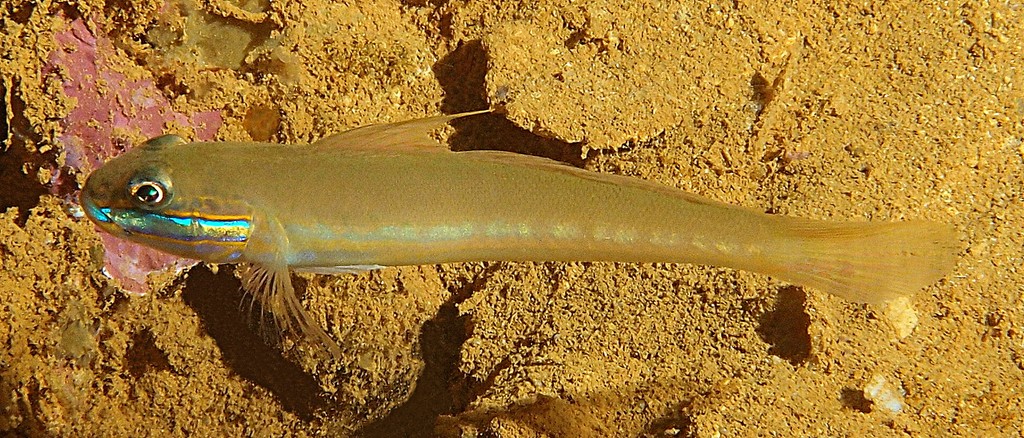VALENCIENNEA RANDALLI - (HOESE & LARSON, 1994)
Actinopterygii (Gigaclass) > Actinopteri (Class) > Teleostei (Subclass) > Gobiiformes (Order) > Gobioidei (Suborder) > Gobiidae (Family) > Gobiinae (Subfamily) > Valenciennea (Genus)
Green-band sleeper-goby, Greenband glider goby, Greenband glidergoby, Greenband goby, Grüngebänderte Grundel, Aohachihaze, アオハチハゼ, 兰氏凡塘鳢, 兰氏凡塘鳢,
Description
Dorsal spines (total): 6-7; Dorsal soft rays (total): 16-18; Anal spines: 1; Anal soft rays: 16-18; Pectoral fin rays: 19-21 (rarely: 19); Longitudinal scale series: 76-81; Depth of body 5.0-5.9 in SL.. Third dorsal spine longest and prolonged in adult; Rhomboid caudal fin, longer than head; Ctenoid body scales, becoming cycloid below first dorsal fin; Head or midline of nape without scales; Side of nape with scales extending forward to above middle of operculum; Fully scaled pectoral fin base and prepelvic area in adult. Max. length: 16.0 cm SL. Depth range: 8 - 30 m.
Color
Pale grey body color with red and blue-edged blue-green stripe below eye; Faint orange stripe along lower side.
Etymology
Valenciennea: in honnor of Achille Valenciennes (1794-1865) who was a French zoologist. He worked with Auguste Henri André Duméril (1812-1870), Georges Cuvier (1769-1832) and Bernard Germain de Lacépède (1756-1825) since 1815. He worked on the 22-volume of a "Histoire naturelle des poissons" (1828-1848), carrying on alone after Georges Cuvier died in 1832.
randalli: named for esteemed ichthyologist John Ernest "Jack" Randall (1924-2020). He was an American ichthyologist and a leading authority on coral reef fishes. Randall described over 600 species and authored 11 books and over 670 scientific papers and popular articles. He spent most of his career working in Hawaii.
Original description: Valenciennea randalli Hoese & Larson, 1994 - Type locality: burrow under metal debris, yacht harbor, Honiara, Guadalcanal, Solomon Islands, western Pacific, depth 16 meters.
Distribution
Eastern Indian Ocean, western Pacific: Andaman Sea and Indonesia east to New Ireland (Papua New Guinea), north to Ryukyu Islands (Japan), south to Queensland (Australia) and New Caledonia.
Green-band sleeper-goby, Greenband glider goby, Greenband glidergoby, Greenband goby, Grüngebänderte Grundel, Aohachihaze, アオハチハゼ, 兰氏凡塘鳢, 兰氏凡塘鳢,
Description
Dorsal spines (total): 6-7; Dorsal soft rays (total): 16-18; Anal spines: 1; Anal soft rays: 16-18; Pectoral fin rays: 19-21 (rarely: 19); Longitudinal scale series: 76-81; Depth of body 5.0-5.9 in SL.. Third dorsal spine longest and prolonged in adult; Rhomboid caudal fin, longer than head; Ctenoid body scales, becoming cycloid below first dorsal fin; Head or midline of nape without scales; Side of nape with scales extending forward to above middle of operculum; Fully scaled pectoral fin base and prepelvic area in adult. Max. length: 16.0 cm SL. Depth range: 8 - 30 m.
Color
Pale grey body color with red and blue-edged blue-green stripe below eye; Faint orange stripe along lower side.
Etymology
Valenciennea: in honnor of Achille Valenciennes (1794-1865) who was a French zoologist. He worked with Auguste Henri André Duméril (1812-1870), Georges Cuvier (1769-1832) and Bernard Germain de Lacépède (1756-1825) since 1815. He worked on the 22-volume of a "Histoire naturelle des poissons" (1828-1848), carrying on alone after Georges Cuvier died in 1832.
randalli: named for esteemed ichthyologist John Ernest "Jack" Randall (1924-2020). He was an American ichthyologist and a leading authority on coral reef fishes. Randall described over 600 species and authored 11 books and over 670 scientific papers and popular articles. He spent most of his career working in Hawaii.
Original description: Valenciennea randalli Hoese & Larson, 1994 - Type locality: burrow under metal debris, yacht harbor, Honiara, Guadalcanal, Solomon Islands, western Pacific, depth 16 meters.
Distribution
Eastern Indian Ocean, western Pacific: Andaman Sea and Indonesia east to New Ireland (Papua New Guinea), north to Ryukyu Islands (Japan), south to Queensland (Australia) and New Caledonia.
Biology
Inhabits coastal estuaries and muddy slopes adjacent to algal reef. Solitary. Found in mud or fine silty sand bottoms. usually in the vicinity of its burrow.
Inhabits coastal estuaries and muddy slopes adjacent to algal reef. Solitary. Found in mud or fine silty sand bottoms. usually in the vicinity of its burrow.
